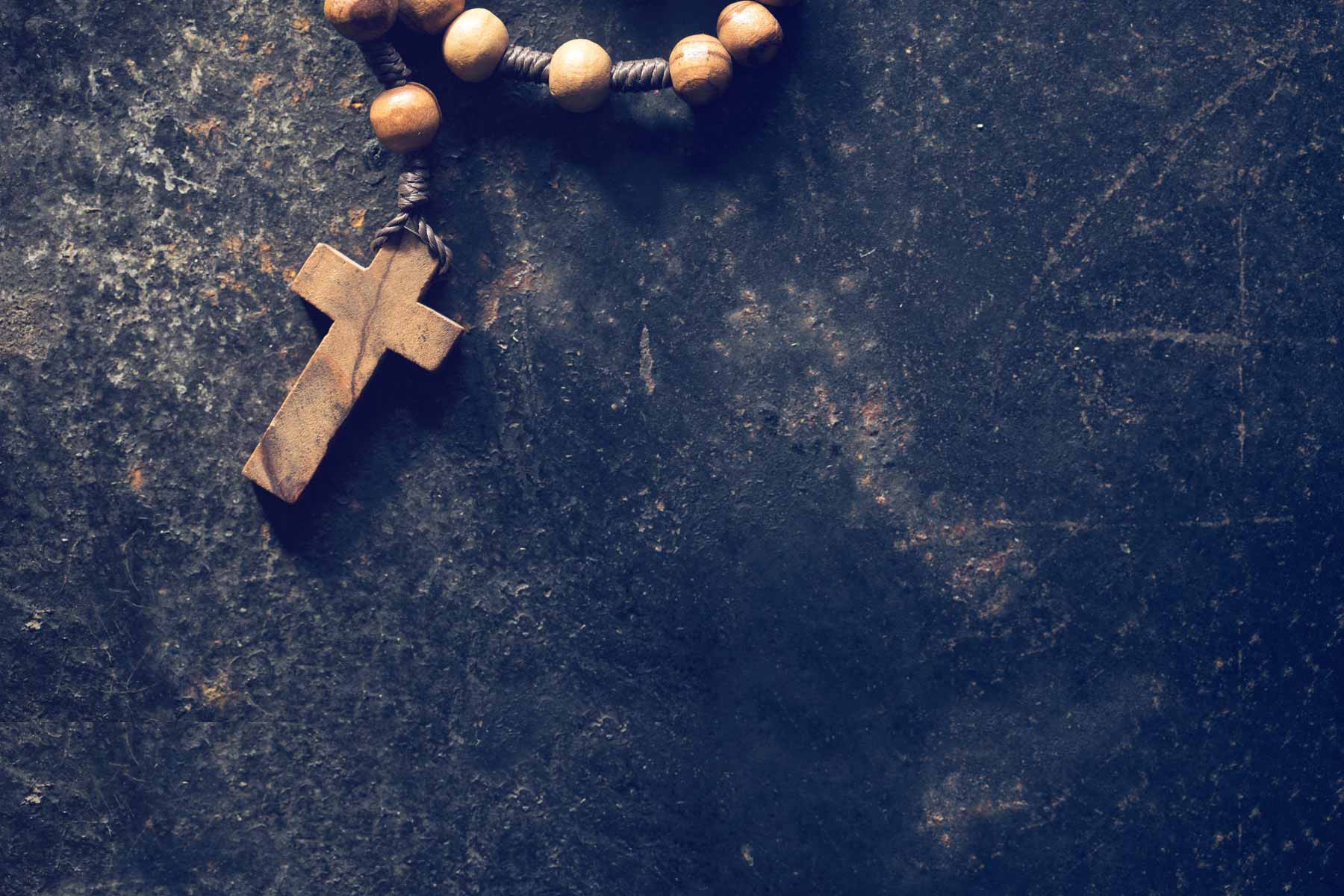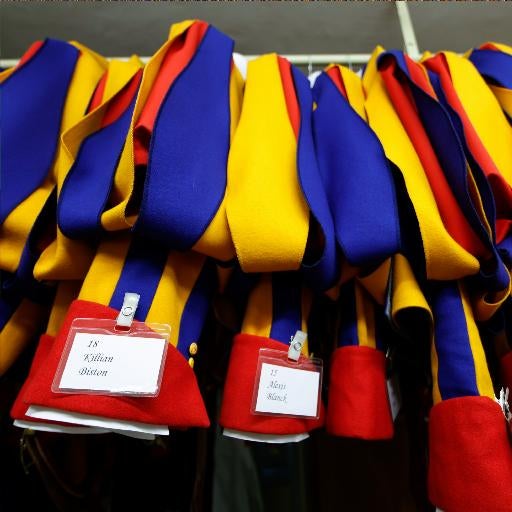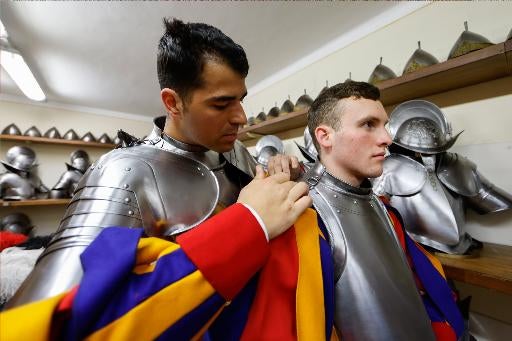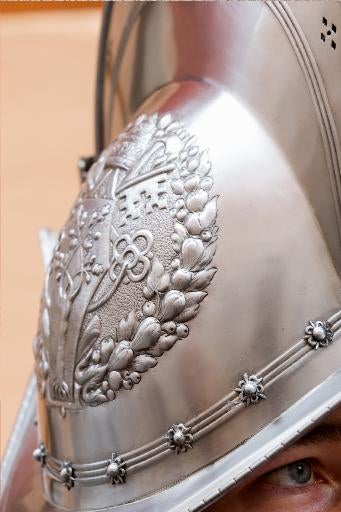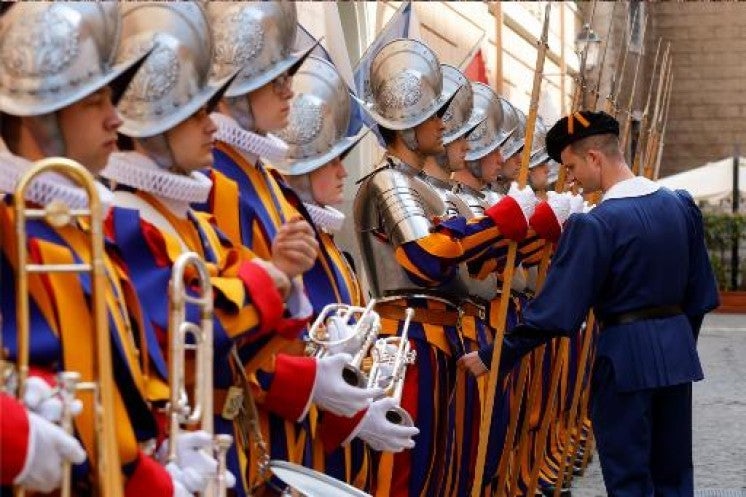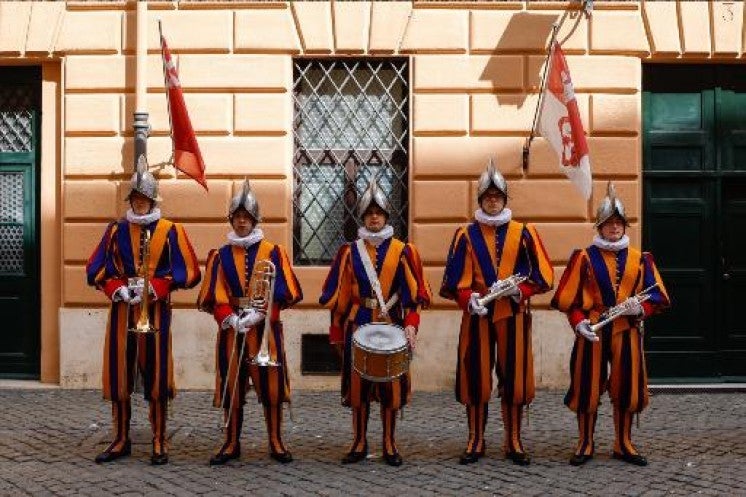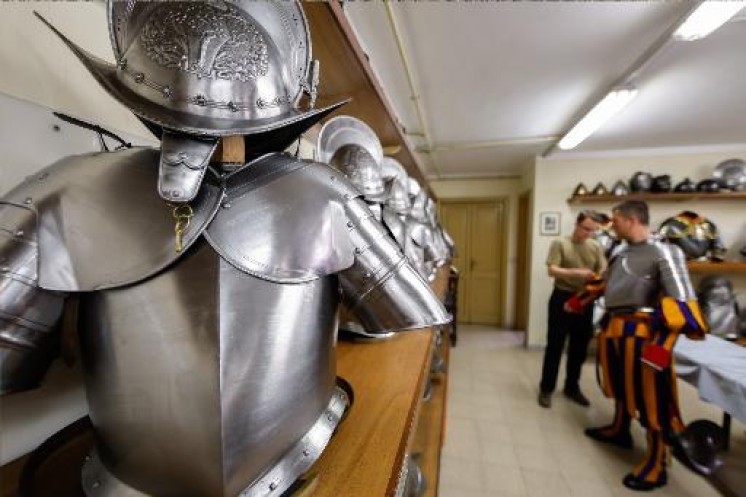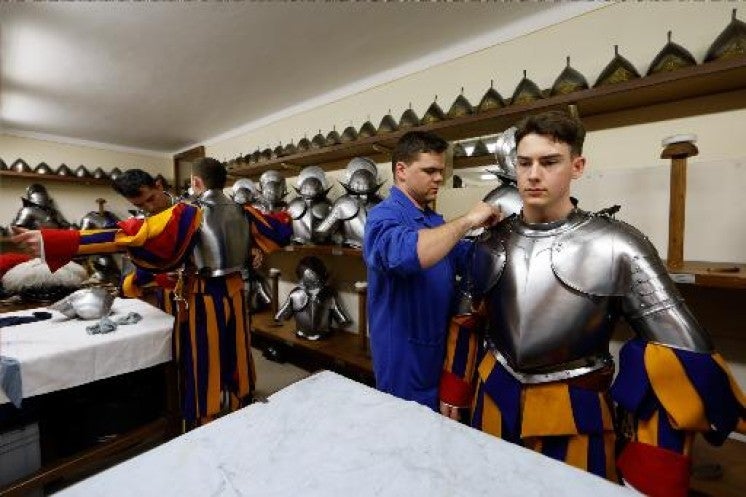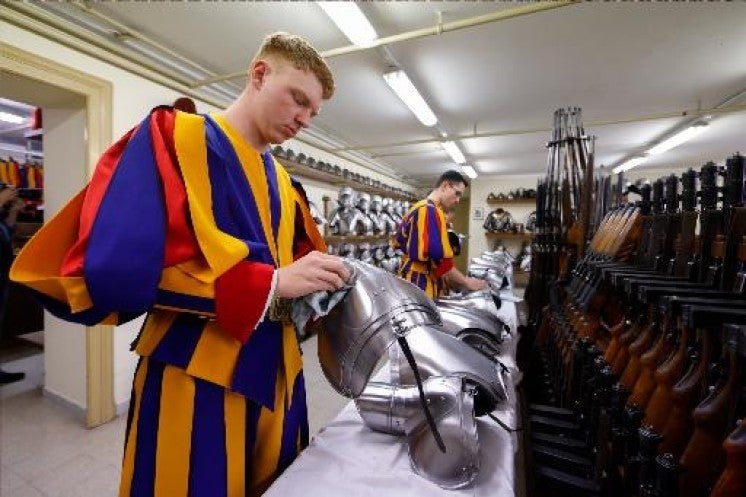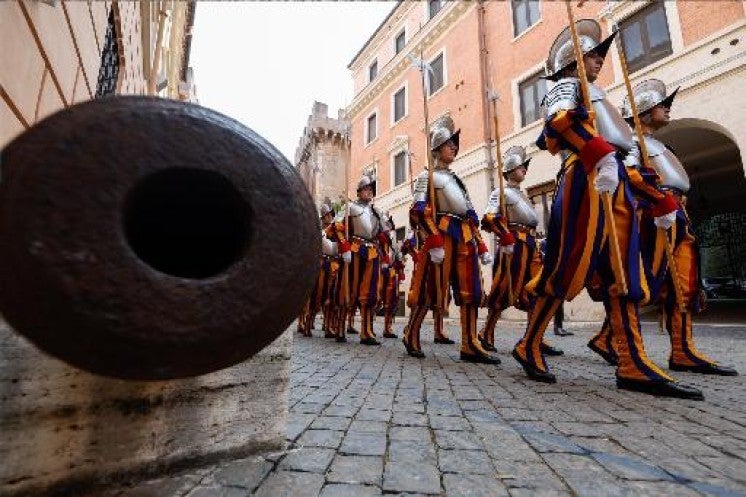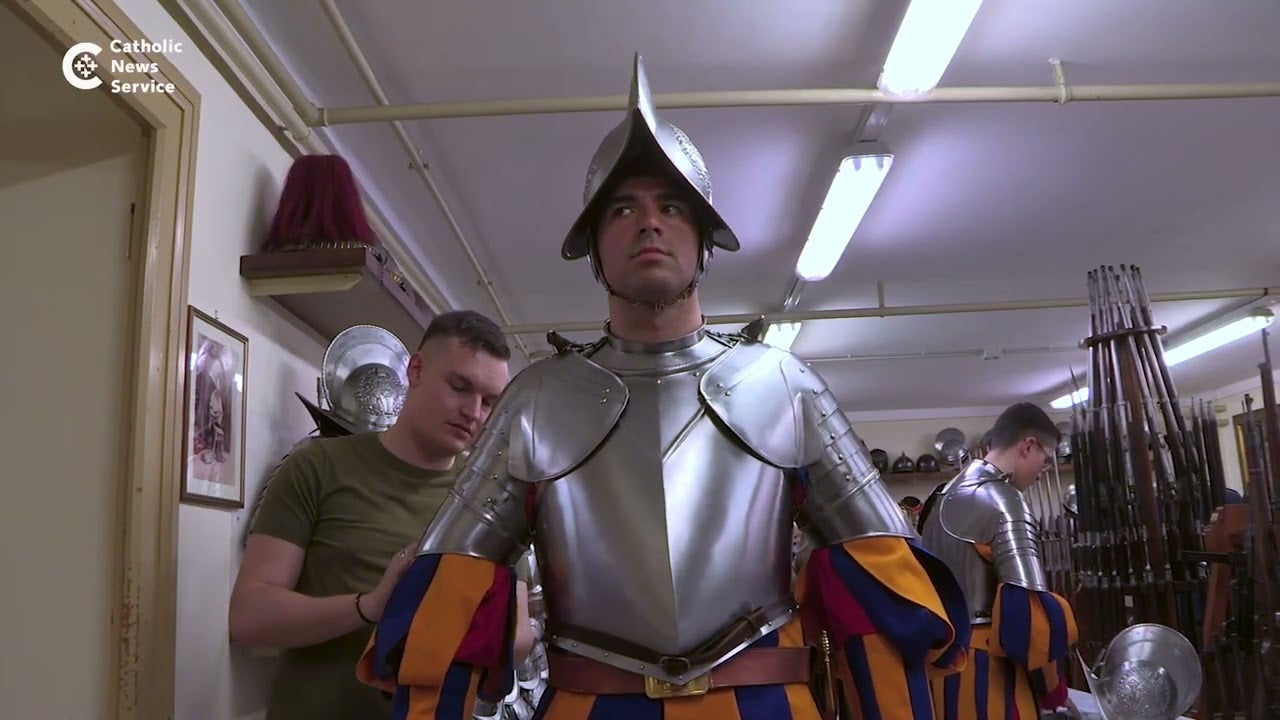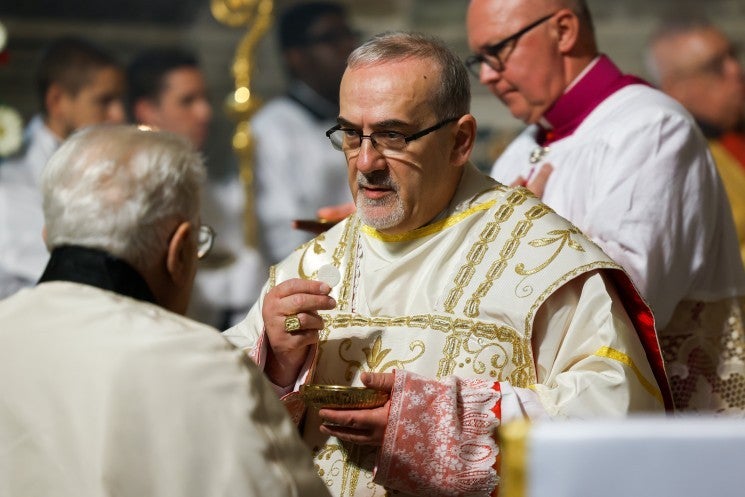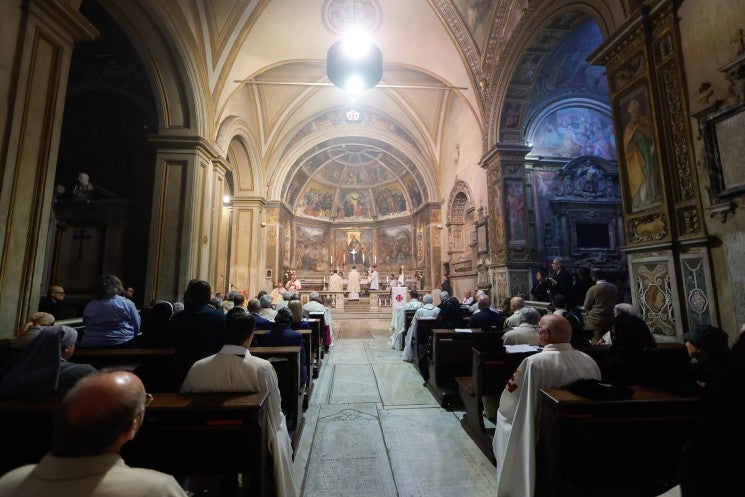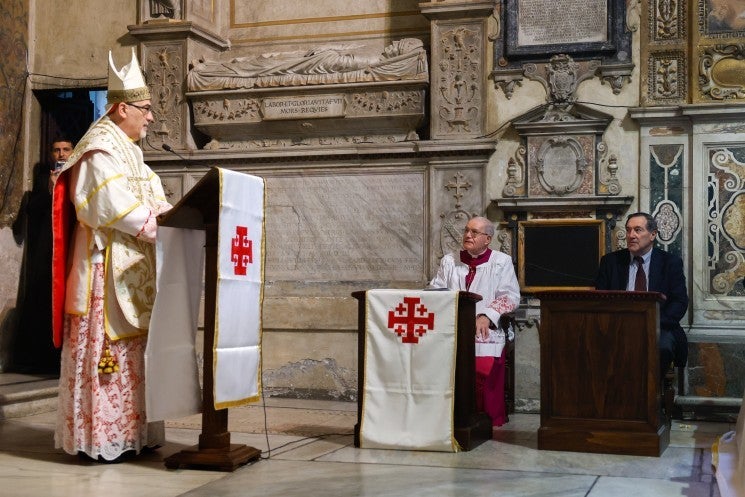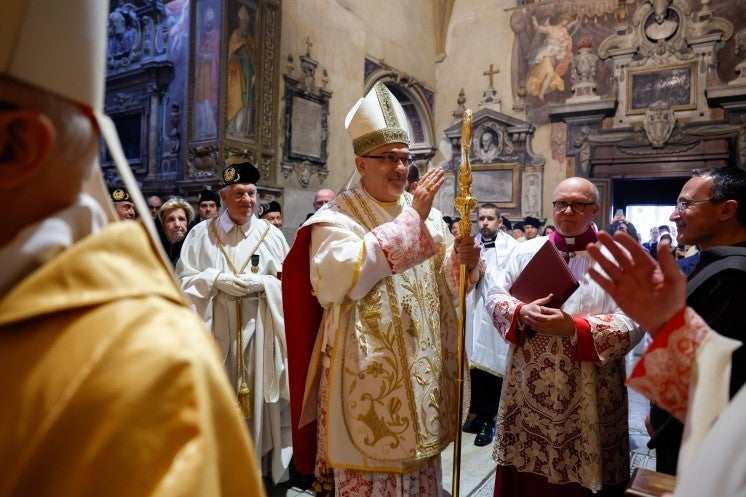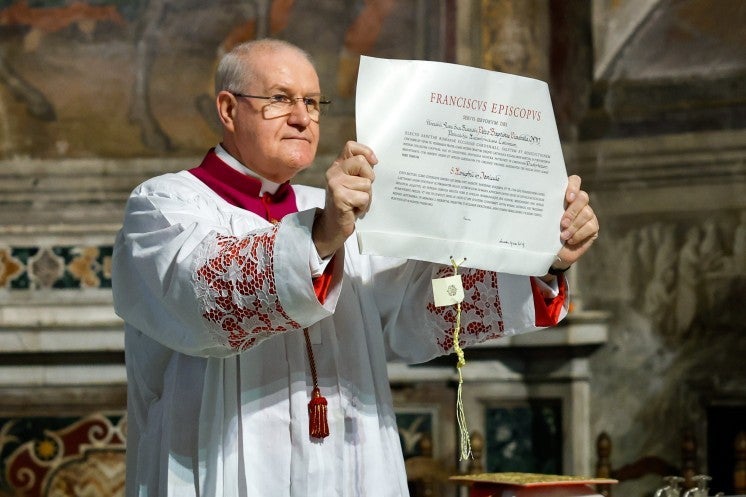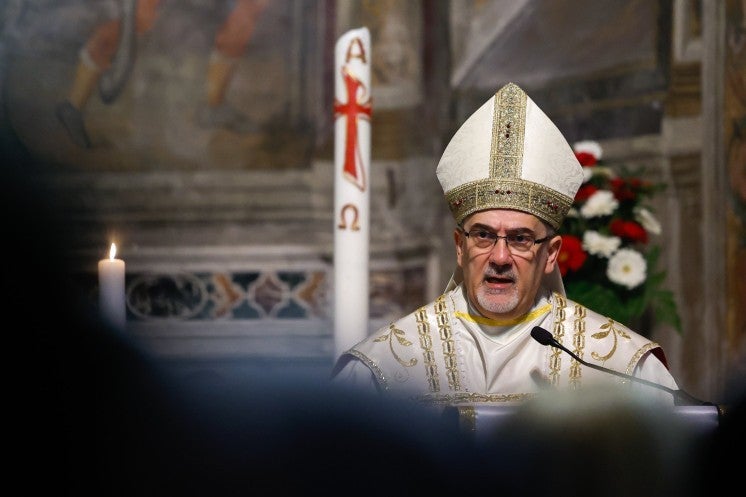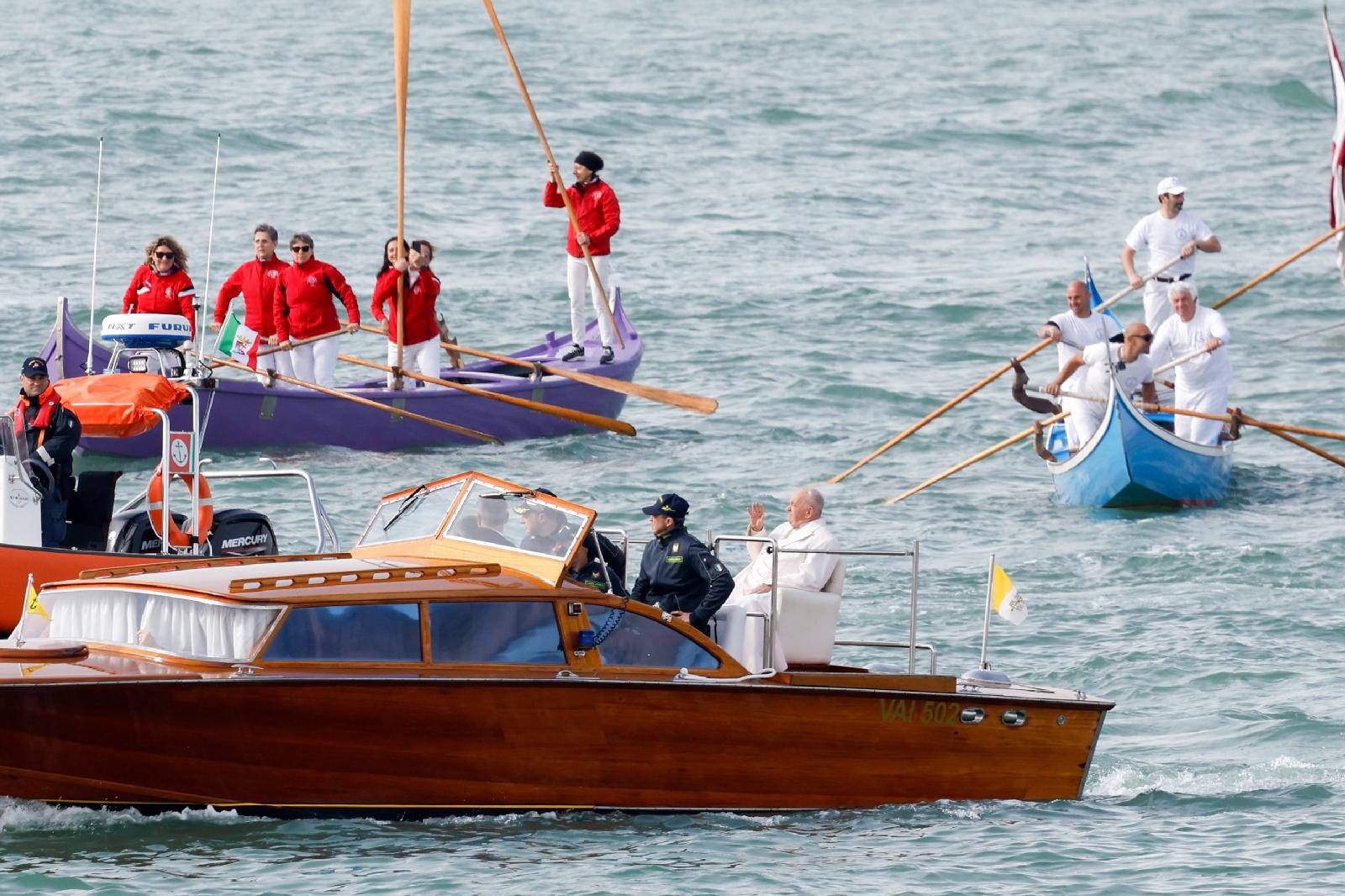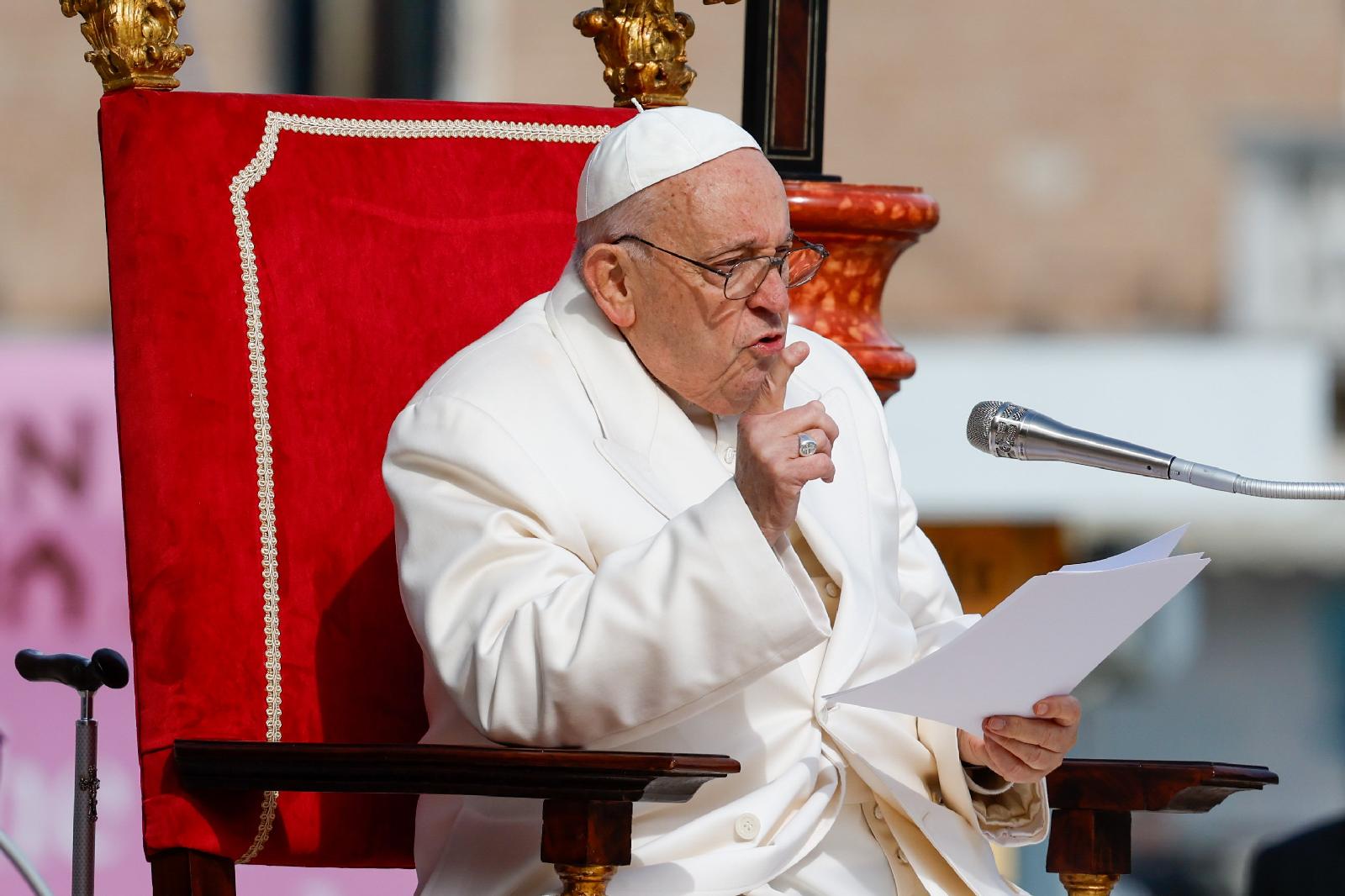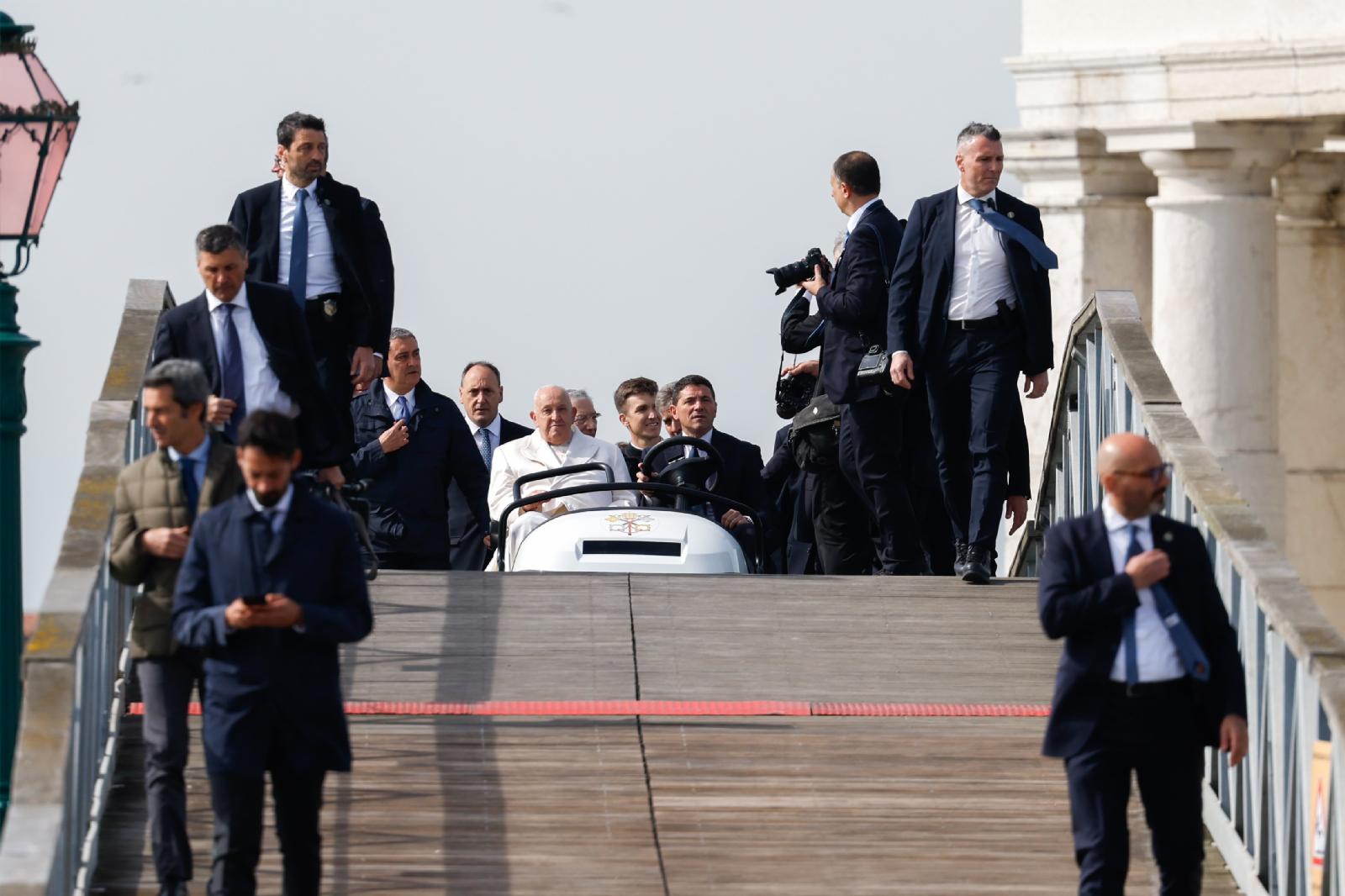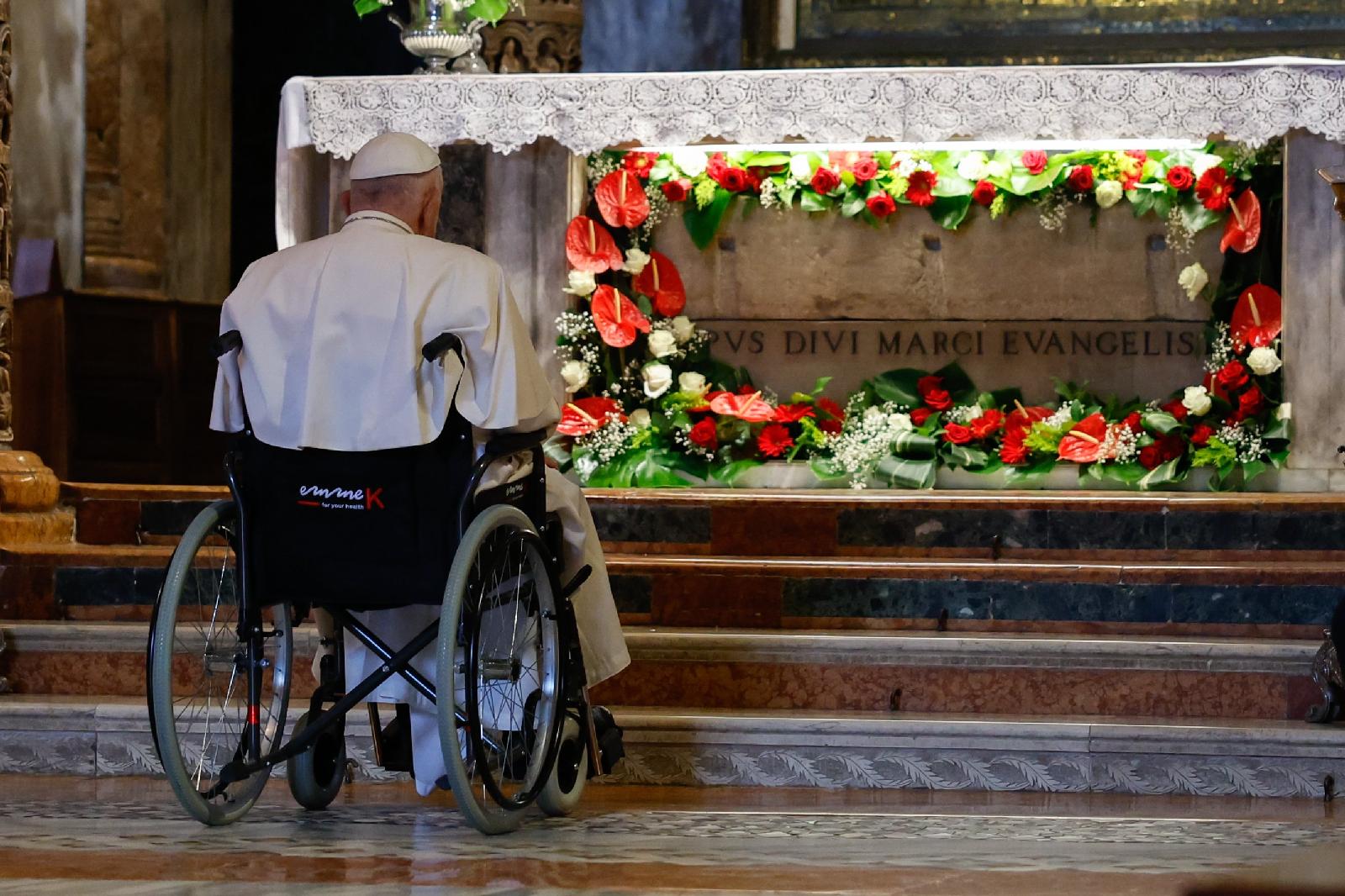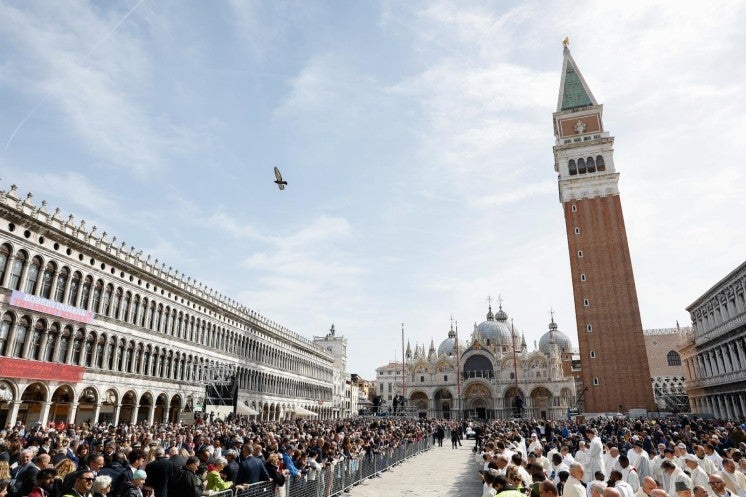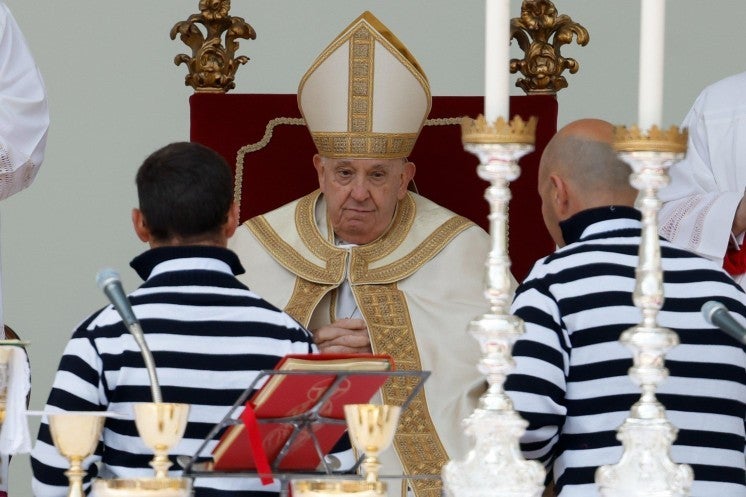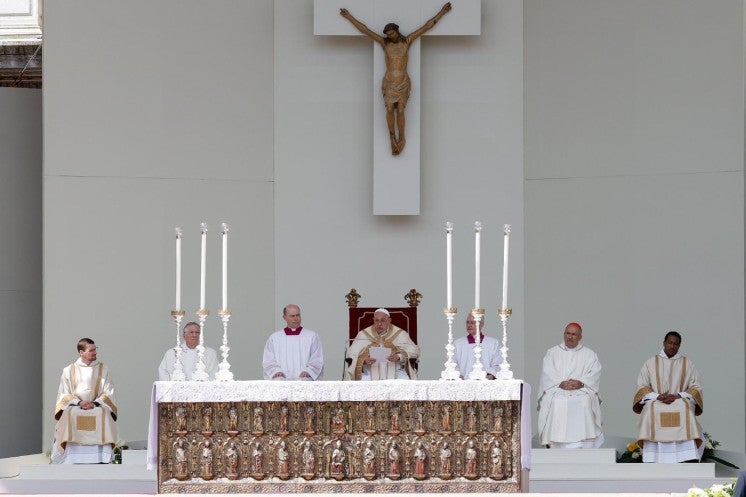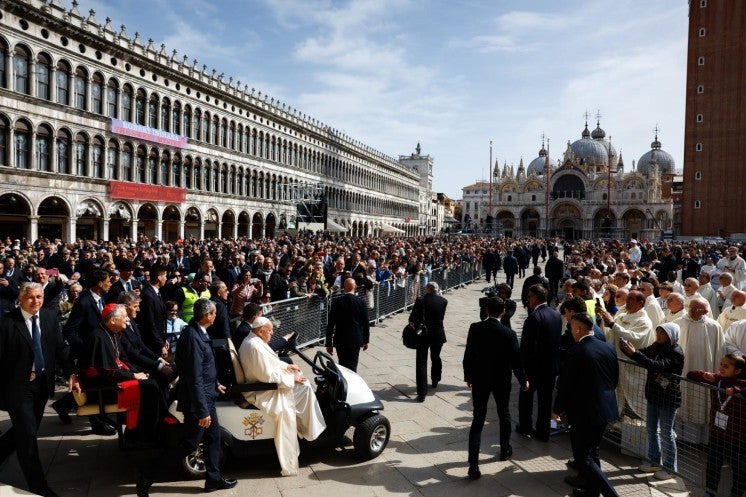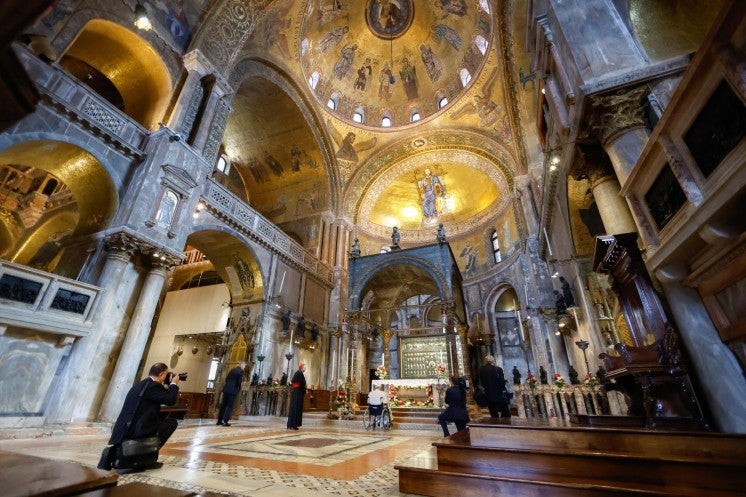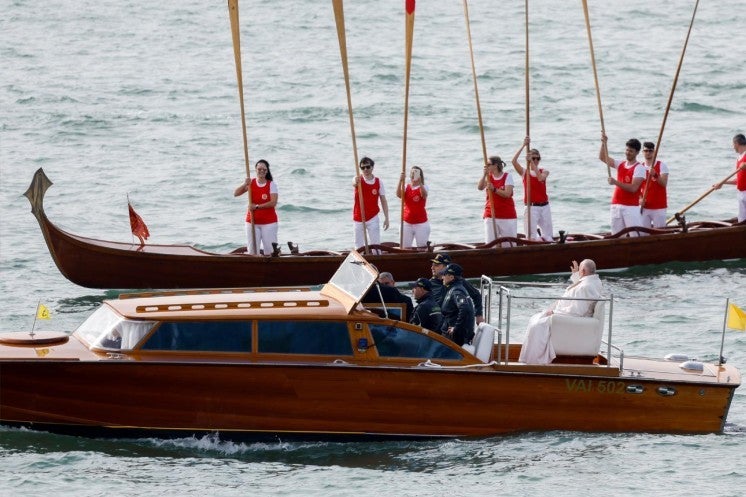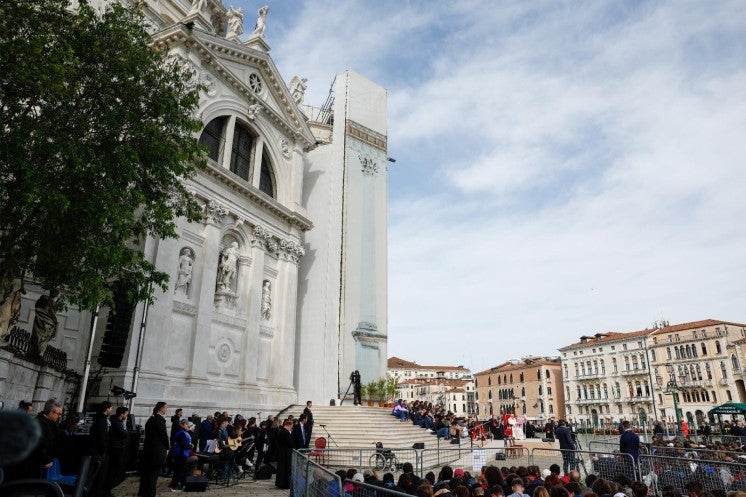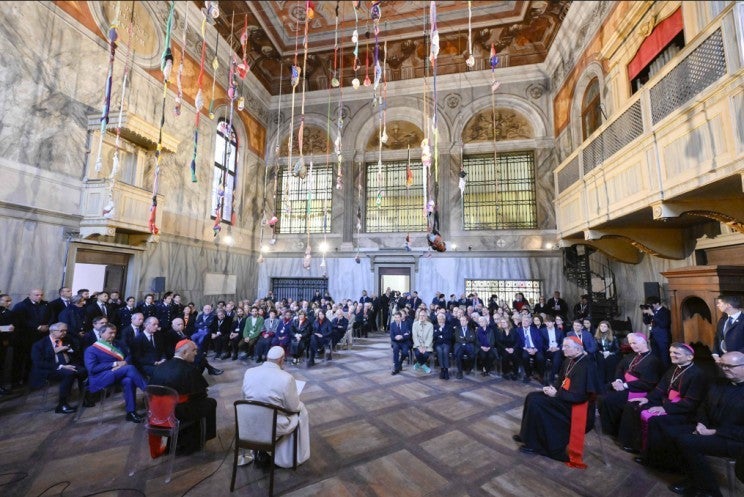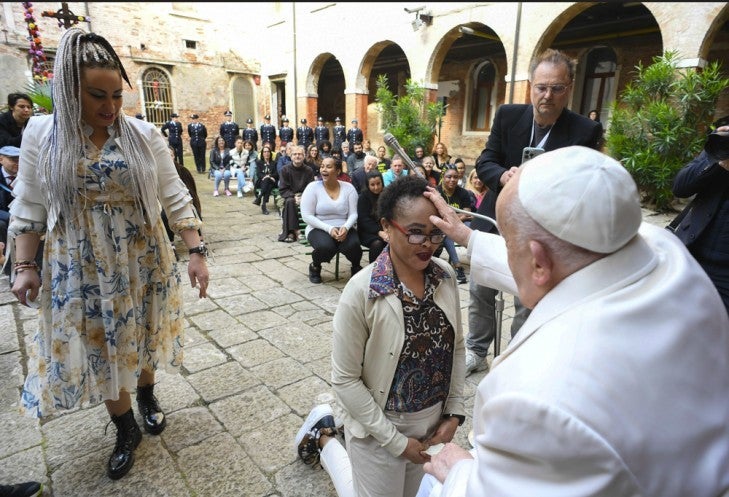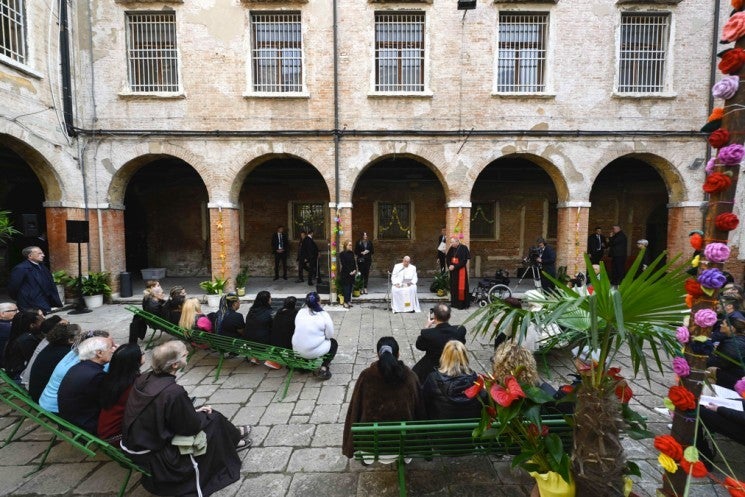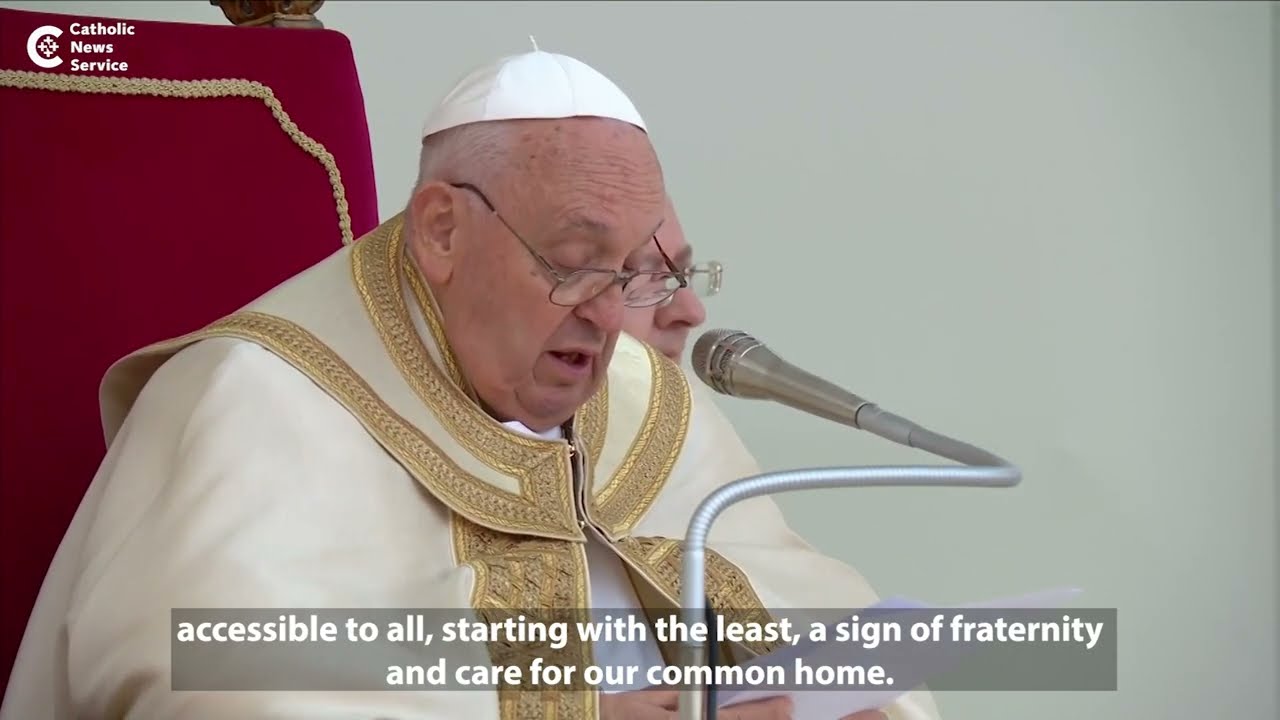Browsing News Entries
Mightier than the sword: Words are a Swiss Guard's best weapon
Posted on 05/3/2024 07:30 AM (USCCB News Releases)
VATICAN CITY (CNS) -- One of the oldest military corps in the world, the Pontifical Swiss Guard, has always armed itself with the best gear available in its 518 years of active service protecting the pope.
From 16th-century armaments of halberds, longswords and cannons to modern-day automatic assault rifles, Glock pistols, tasers and pepper spray, the guard's arsenal and tactical defense training have sought to be the most avant-garde to provide the best security for a high-profile, crowd-loving, globe-trotting leader.
While most tourists may only see the Swiss Guard as colorful and quaint -- standing guard at papal events and surveilling entrances into Vatican City State -- they are top-tier security specialists who actually find their most needed weapon is words.
"We have been trained in different combat techniques," as well as taken courses in psychology and situational assessment, said Corporal Eliah Cinotti, media officer of the Pontifical Swiss Guard.
But "nowadays you have to understand that the best weapon is talking. Until now we have had 100% (success) because we always manage to alleviate situations by talking," he told reporters April 30 in the courtyard behind the guards' barracks.
Thousands of people stream into St. Peter's Square, the basilica and the Paul VI Audience Hall for papal events and even more walk each day by the major entrances into the tiny city state where the guards are more at liberty to interact freely with the public.
While most passersby are inquisitive and curious, there has been "a significant increase" in the number of people experiencing some form of crisis, Corporal Cinotti said.
"There are more lonely people looking for comfort and maybe they see it in the Vatican," he said. There are also more individuals who might have some kind of psychological or mental disturbance "who come up to us and perhaps even ask for a word of comfort, a word of support."
While the 135 guards may work anywhere from six- to 12-hour days, he said the hardest part of the job is coming face-to-face, not with potential or actual troublemakers, but with those who are desperately seeking help.
Hardly distant sentinels, the guards, who are on average 22 years old, hear heart-wrenching stories from people.
Some people may have lost their job and have a large family to support, he said, or "there are people maybe who want to take their own life, and we have to stop this person from taking their life."
Others might say they absolutely must see the Holy Father, "and we cannot allow everyone into the Vatican, so we are always trying to have a solution," the corporal said. Most often people are "looking for a specific kind of help," and the Vatican is seen as a kind of "last resort."
"When we are serving the entrances, we are also there to be an ear that listens, too, and it is also part of our Christian formation," he said. The Swiss Guard is open only to Swiss male citizens who have graduated from high school, served in the Swiss Army, stand at least 5 feet 8 inches tall, are under 30 years of age and are Catholic.
"The pope always says that we are a calling card for the Vatican," he said, since the guards are such highly visible and relatively accessible public-facing figures. "But more importantly we are a bit like a messenger of the Gospel on the ground."
"We are also there to be Christians," which means trying to help others, he said. "We know what to do, but in the moment also sometimes a good word or even maybe putting yourself in the person's place helps. Listening especially helps."
The fact the Vatican is "a hot spot" for so many visitors is one thing that makes the job so unique, said Renato Peter, 24, who joined the Swiss Guard in September.
Most visitors are friendly, they might have a question or want a photo or information, he said, but that means it's also difficult to see which people might be trouble. While police officers typically head out to where a specific problem has been called in, for the Swiss Guard, "the problem comes to us" with no warning.
But working "on the border" at the entrances to Vatican City State is also one of the best parts of the job, he said, as it gives him a chance to meet people from all over the world.
Peter said he decided he wanted to be a Swiss Guard when he was 12 years old when his Diocese of St. Gallen organized a trip to the Vatican for a general audience in 2012. They visited the guards' barracks in the afternoon, "and then I said, 'Yeah, that's a cool job.'"
Peter, who will be officially sworn-in as a guard with 33 other young men May 6, said he thinks "it's really great" to serve Pope Francis who has been listed a number of times by Forbes magazine as one of the "Most Powerful People" in the world and is a "spiritual mentor" to 1.39 billion Catholics around the world.
The recruit likes the camaraderie and friendships he's made, but he is not a fan of Rome's heat, which can reach 107 degrees Fahrenheit or more. It's a job where sometimes "you don't do anything, but you sweat a lot."
Pope calls pastors to be 'missionaries of synodality'
Posted on 05/2/2024 07:30 AM (USCCB News Releases)
VATICAN CITY (CNS) -- Pope Francis signed a letter on synodality in the presence of parish priests and urged them to be "missionaries of synodality," said several of the priests present.
Father Donald J. Planty Jr., pastor of St. Charles Church in Arlington, Virginia, and one of the U.S. pastors at the meeting, said, "He told us, 'I want you to take this letter, and I want you to put it into action. I want you to share it and speak to your bishops about it and speak to your brother pastors about it.'"
The pope signed the letter May 2 as he met with more than 200 parish priests in the Vatican Synod Hall. The meeting came at the end of an April 29-May 2 gathering designed as an opportunity for the priests to share their experiences and offer input for the drafting of the working document for the Synod of Bishops on synodality's second assembly in October.
Father Planty, who served for a time in the Vatican diplomatic corps and in the Vatican Secretariat of State, said it was clear that what participants from around the world had in common was "love for our identity as priests and our mission as priests."
Clearly, he said, some priests have difficulty getting parishioners to open up and share their hopes, dreams and skills -- a crucial part of building a "synodal church" where people listen to one another and share responsibility for the life of the parish and its missionary outreach.
That is not a problem in the United States, Father Planty said. "Especially in a country of an Anglo-Saxon democratic tradition," people are used to sharing their opinions, including with their priests. They comment after Mass or send an email or phone the parish office.
"A priest who really knows his parish, loves his parishioners, has his finger on the pulse of the parish" not only through the pastoral council and finance council but "also through other, informal settings," he said. Such a pastor "knows his people, consults with them, listens to them, takes their advice, and ultimately that factors into his pastoral decisions and planning and actions."
Father Clint Ressler, pastor of St. Mary of the Miraculous Medal Catholic Church in Texas City, Texas, said spiritual discernment adds a key factor because synodality "is not listening to the voice of the people, but the voice of God in the voice of the people."
"It isn't just about your voices and your opinions," he said. "We have to all be willing to then go deeper beneath those voices to try to hear what the Spirit is saying among us."
People are hesitant about synodality when it is erroneously presented as debating "the issues that are controversial in the church" and "whether or not this is some new instrument to foment change in doctrine or church teaching," he said. When that happens, "I think it's disturbing. It's scary. It's unsettling," and it leaves some wondering, "Why are we going to let the people decide what God wants?"
Father Paul Soper, pastor of St. Margaret Mary and St. Denis parishes in Westwood, Massachusetts, and secretary for ministerial personnel in the Archdiocese of Boston said priests and laypeople who have fears or concerns about synodality are afraid of different things.
"The fear of the priests is that there is a degree of randomness to the process," he said, and that the synod "is going to be recommending big changes in the life of the church somehow or another that will have come from a bunch of random voices rather than from a clearly traceable conciliar process."
"I think what the people fear is different," he said. "I think that they fear that this is a conversation that's not going to go anywhere. That it will simply, in the end, be a collection of reflections on the process of reflecting -- a meeting on meetings, if you will."
But, he said, his experience in evangelization has taught him that the "deep listening" or "contemplative listening" that the synod process is teaching people is what will enable Catholics to understand other people's stories and invite them into or back into a relationship with Jesus and with the church.
Father Robert L. Connors, director of the Office for Senior Priests in the Archdiocese of Boston and episcopal vicar of the archdiocese's south region, said the synod's emphasis on listening also can help Catholics "learn the art of respect in a world where there is very little respect."
And, especially in parishes and dioceses where there is growing diversity, he said, synodality helps people realize, "we're all in this together."
- - -
Contributing to this story was Carol Glatz at the Vatican.
Pope Francis Accepts Resignation of Archbishop Leonard Blair of Hartford; Succeeded by Coadjutor Archbishop Christopher Coyne
Posted on 05/1/2024 07:30 AM (USCCB News Releases)
WASHINGTON - Pope Francis has accepted the resignation of Archbishop Leonard P. Blair, 75, from the Office of Archbishop of Hartford. Archbishop Christopher J. Coyne, up until now coadjutor archbishop of the same diocese, will succeed him as archbishop of Hartford.
The resignation and appointment were publicized in Washington, D.C. on May 1, 2024, by Cardinal Christophe Pierre, apostolic nuncio to the United States.
Archbishop Coyne’s biography may be found here.
The Archdiocese of Hartford is comprised of 2,288 square miles in the State of Connecticut and has a total population of 1,949,519 of which 543,341, are Catholic.
###
Cardinal says church shouldn't expect 'miracle' of peace in Holy Land
Posted on 05/1/2024 07:30 AM (USCCB News Releases)
ROME (CNS) -- Sudden peace negotiations or an intervention by the United States will not deliver Israelis and Palestinians from the suffering caused by the war in Gaza, a Jerusalem-based cardinal said.
As a result of the war, the rift between Israelis and Palestinians is "deeper than it has ever been," Cardinal Pierbattista Pizzaballa, patriarch of Jerusalem, said May 1.
"We are all waiting for something big, something that changes the course of the history of events," he said in his homily during a Mass to formally take possession of his titular church in Rome. "We all want the United States to resolve the problem; we all want the peace negotiations to end in something big, important, in a way that marks the course of history."
But "this is not the way the kingdom of God grows," he said. "The kingdom of God grows in community, with communal gestures, calmly, little by little."
The kingdom of God is not "a miracle that is performed, suddenly changing the fate of the world," the cardinal said, rather it is "a seed sown in the ground that dies and little by little grows and bears fruit." The Catholic Church, he added, is called to be that slowly but steadily growing seed.
Cardinal Pizzaballa preached before a packed congregation in the small, historic Church of St. Onuphrius on the Janiculum Hill in Rome as he formally took possession of the church, a tradition meant to seal his identity as a member of the clergy of Rome. In ancient times, the cardinals who elected popes were pastors of the city's parishes.
Knights and dames of the Equestrian Order of the Holy Sepulchre of Jerusalem, dressed in their ceremonial capes, joined the cardinal for the celebration. The ancient Catholic chivalric order supports the Latin Patriarchate of Jerusalem with prayers, financial assistance and regular pilgrimages. Cardinal Fernando Filoni, grand master of the order, participated in the Mass as did Cardinal Leonardo Sandri, vice dean of the College of Cardinals.
The congregation at the Mass also included Franciscan friars, the order to which Cardinal Pizzaballa belongs. The Church of St. Onuphrius, established in 1439, has been under the care of Franciscan Friars of the Atonement, a religious congregation founded in the United States, since 1946.
Joe Donnelly, U.S. ambassador to the Holy See, was also present for the Mass.
After the Mass, Cardinal Pizzaballa told reporters that he struggles to understand the protests taking place across college campuses in the United States over academic institutions' investments in companies that do business with Israel.
"Universities are places where cultural debate, even when heated, even when tough, should be available at 360 degrees," he said. "The contrast of completely different ideas, harsh as they may be, must be expressed not through violence or boycotting, but by knowing how to confront one another."
"The world is made of different opinions that must be confronted, not by explosions but by discussions," he said.
The Mass began with the reading of the formal declaration from Pope Francis assigning the church to Cardinal Pizzaballa when he was made a cardinal Sept. 30, 2023.
"It's stupendous that the pope thought that the patriarch of Jerusalem should be a cardinal," said Cardinal Filoni while greeting Cardinal Pizzaballa on behalf of the Order of the Holy Sepulchre at the close of Mass. "Today it unites Jerusalem, the Holy Land and the patriarchate which you represent, with the church of Rome."
National Day of Prayer and Remembrance for Mariners and People of the Sea to Include Special Prayer for Those Impacted by Baltimore Key Bridge Tragedy
Posted on 05/1/2024 07:30 AM (USCCB News Releases)
WASHINGTON – Each year, National Maritime Day (May 22) recognizes the men and women who work or travel on the high seas. It is on this day the Catholic Church observes the National Day of Prayer and Remembrance for Mariners and People of the Sea and highlights the ministry of Stella Maris (Star of the Sea), the apostolate of the Catholic Church for the people of the sea. Bishop Brendan J. Cahill of Victoria in Texas, the bishop-promoter of Stella Maris in the United States, invites the faithful to support, remember, and pray for the many men and women who earn their livelihood through work on the seas, including merchant mariners, seafarers, fishermen, port personnel, and those in the maritime industry.
This year, Bishop Cahill is calling for special prayers of remembrance for those affected by the March 26 tragedy of the Francis Scott Key Bridge collapse in Baltimore. A Mass for the Day of Prayer and Remembrance for Mariners and People of the Sea will be offered on Saturday, May 18 at the Basilica of the National Shrine of the Immaculate Conception in Washington, D.C. at 12:10 p.m. In the immediate wake of the cargo ship accident and bridge collapse, the Stella Maris network of port chaplains and partners mobilized to provide pastoral care and support for the crew members of the cargo ship Dali that made impact with the bridge and for crew members of other vessels in the Port of Baltimore.
“Each year, we pray for those who work on the high seas and the ports. In a special way this year, we remember those who have been impacted by the collapse of the Key Bridge, particularly the six construction workers who perished in the bridge collapse, and for their families as they mourn the loss of their loved ones,” said Bishop Cahill. “And we also pray for the captain and crew of the cargo ship, and the countless people who have been working in the aftermath of the tragedy, including the U.S. Coast Guard, Army Corps of Engineers, dive teams, first responders, construction workers, law enforcement, and government officials. Still impacted are also the thousands of dockworkers and those who rely for work in the Port of Baltimore. Worldwide, there are countless men and women who labor on the high seas for their livelihood -- let us seek the intercession of Our Lady, Star of the Sea, that she protect and guide us,” he continued.
For more information on the annual Mass, please visit: https://www.nationalshrine.org/event/annual-maritime-day-mass-2024, and for more information on the ministry of Stella Maris, please visit: https://www.usccb.org/stellamaris.
###
Health Care that Truly Heals Must be Grounded in Truth, says Bishop Rhoades
Posted on 04/30/2024 07:30 AM (USCCB News Releases)
WASHINGTON - “Health care that truly heals must be grounded in truth,” said Bishop Kevin C. Rhoades of Fort Wayne-South Bend, responding to the U.S. Department of Health and Human Services’ (HHS) issuance of final regulations implementing the nondiscrimination provisions of the Affordable Care Act, known as Section 1557. By including “sexual orientation and gender identity” in the definition of “sex,” the final regulations generally require health care workers to perform “gender transition” procedures in the name of nondiscrimination. At the same time, the regulations make modest improvements to the proposed regulations’ protections for the exercise of conscience, religious belief, and clinical judgment.
Speaking as chairman of the Committee for Religious Liberty for the U.S. Conference of Catholic Bishops (USCCB), he added:
“The human right to health care flows from the sanctity of human life and the dignity that belongs to all human persons, who are made in the image of God. The same core beliefs about human dignity and the wisdom of God’s design that motivate Catholics to care for the sick also shape our convictions about care for preborn children and the immutable nature of the human person. These commitments are inseparable.
“We appreciate that the final rule does not attempt to impose a mandate with regard to abortion. These regulations, however, advance an ideological view of sex that, as the Holy See has noted, denies the most beautiful and most powerful difference that exists between living beings: sexual difference. I pray that health care workers will embrace the truth about the human person, a truth reflected in Catholic teaching, and that HHS will not substitute its judgment for their own.”
The USSCB submitted comments on the proposed regulations issued by HHS in 2022, and the USCCB Committee for Religious Liberty highlighted the regulations as a major threat to religious liberty in its annual report issued in January.
###
New photos reveal many sides of Padre Pio
Posted on 04/30/2024 07:30 AM (USCCB News Releases)
VATICAN CITY (CNS) -- A foundation that promotes devotion to St. Pio of Pietrelcina, more widely known as Padre Pio, is making 10 never-before-seen photographs of the saint available to the devout for free.
The images provide personal insight into the life, attitude and spirituality of 20th-century saint, said the photographer. Some photos show Padre Pio solemnly celebrating Mass while in others he is smiling while surrounded by his confreres.
Elia Stelluto, Padre Pio's personal photographer, stood proudly -- camera in hand -- before posters of the 10 new images for the presentation of the photos in the Vatican movie theater April 29.
"It's enough to look at one image of his face" to understand Padre Pio, he told Catholic News Service. "With that you can understand so much; each photo has its own story, one must at them look one by one and that way you see so much more in his expressions."
Stelluto photographed the saint for decades at the convent where he lived in San Giovanni Rotondo, Italy.
During the photo presentation, Andrea Tornielli, editorial director of the Dicastery for Communication, said the new photos highlight Padre Pio's identity as someone who was close to those around him and was filled with joy. He said that although it was not customary to smile in photos at the time, candid photos taken by Stelluto show the saint beaming broadly as he was huddled in a group.
Luciano Lamonarca, founder and CEO of the Saint Pio Foundation which promotes devotion to the Italian saint and organized the publication of the photos, said many people would come to Stelluto requesting his photos for articles and books.
"I never saw any kind of availability for the people" to see the photos directly, he said. That's why he thought, "Padre Pio is the saint of the people, we must do something for the people."
Lamonarca, an Italian who lives in the United States, said since many people with a devotion to Padre Pio are unable to visit the areas where the saint lived and ministered, he asked himself, "how does one bring Padre Pio to them, the true Padre Pio, the most authentic form of Padre Pio?"
That's what spurred him to partner with Stelluto to make the photos available to the public, excluding their use for commercial purposes, by being free to download via the St. Pio Foundation website.
Lamonarca said he hoped that by "looking at the image of a greatly suffering father who could also laugh," people would think to themselves, "if he could laugh, we can laugh too."
Stelluto described the images he had taken of Padre Pio as "mysterious," since they always came out clearly despite dark lighting conditions.
He recalled the challenge of taking photos in a dark convent, coupled with Padre Pio's distaste for the flash of a camera, especially during Mass, and exclusive use of dim candles to light the altar.
"It's not that I was talented in doing this, I still don't understand the thing," Stelluto said during the photo presentation. "The truth is that he was the source of light."
------
Access to the photos can be requested by following the link: www.therealsaintpio.org
Catholic Communication Campaign Supports National and Local Media that Connect Millions with Christ
Posted on 04/29/2024 07:30 AM (USCCB News Releases)
WASHINGTON - On May 11-12, Catholics across the United States will have an opportunity to support the communications ministry of the Catholic Church, both locally and globally through the Catholic Communication Campaign.
“Saint Peter himself could not have imagined today’s communication ministries when he told the first Christians to have a ready answer for anyone who questioned their faith. He would have been awed with what can be achieved through social media, video, podcasts and apps,” said Archbishop Gregory J. Hartmayer, OFM Conv., of Atlanta, chairman of the U.S. Conference of Catholic Bishops’ (USCCB) Subcommittee on the Catholic Communication Campaign.
“The many means of communications today allow the Catholic Church to use these tools with love, for good and to the glory of God by inviting people to engage more fully in the faith and using them as a means for evangelization. The Catholic Communication Campaign helps to make this a reality.”
Most dioceses take this annual collection in their parishes on the weekend of May 11-12, though some use other dates. Half of the gifts to the diocesan collection stay in the participating diocese where they support the local diocese’s communications programs. The other half supports communication activities of the U.S. Conference of Catholic Bishops and some projects across the United States and abroad.
The Catholic Communication Campaign provides vital funding for the collective communication efforts of the U.S. bishops. More than $3.6 million in campaign funds supported both national and international Catholic media outreach in 2022, as shown in the campaign’s most recent annual report. About 35% of those funds supported evangelization through media, such as podcasts, videos and documentaries. A nearly equal amount underwrote Catholic News Service in Rome, which has provided the Catholic Church in the United States with accurate, in-depth coverage of the Vatican and the Holy Father since 1950.
Smaller amounts subsidized a wide range of projects, such as equipping Church-related social ministries with the digital tools to promote concerns such as ecology, human life and dignity, social justice, and immigration reform. The campaign sponsors Catholic Current, a weekly news show on YouTube and some Catholic television and radio stations that explores the activities of the U.S. bishops. The collection also supports the USCCB’s popular video reflections on the daily Mass readings, which feature lay and religious leaders of diverse cultural backgrounds and pastoral experiences.
For more information and promotional resources visit https://www.usccb.org/ccc. #iGiveCatholicTogether accepts funds for this collection.
###
Synod asks pastors to share stories, see how God is at work
Posted on 04/29/2024 07:30 AM (USCCB News Releases)
VATICAN CITY (CNS) -- By sharing their own stories and those of their parishes, pastors from around the world can help each other see where God is present and, perhaps, discover new paths the Lord wants Catholics to embark on to share the Gospel with the world, said Cardinal Mario Grech, secretary-general of the Synod of Bishops.
"Our stories are human stories, but human stories in which God, Jesus, is present," the cardinal told more than 200 parish priests gathered at Sacrofano outside of Rome April 29 at the beginning of a four-day meeting to share their experiences and contribute to the ongoing synod on synodality. The synod was scheduled to livestream the opening presentations each day.
Participants were chosen by their bishops' conferences or Eastern Catholic synods to represent parish priests working in different environments and with different levels of experience. In fact, the meeting began with Cardinal Grech congratulating a priest from Cameroon celebrating the 24th anniversary of his priestly ordination that day.
"Often it is hard to understand the way in which our stories could be the stories of God. Even I find it difficult for myself," the cardinal told them. "Our parishes are probably far from being the best parish that one could wish for. Our stories are anything but perfect. No wonder we find it difficult to understand, to discern, how our stories are God's."
But, he said, when shared in an atmosphere of prayer, people can help each other see God's presence and notice specifically "how Jesus is working today in you, in your parishes, in your dioceses."
Father Tomáš Halík, a well-known Czech theologian, encouraged the priests to be "humble" and realistic about seeing God's presence in their frustrations and failures as well.
"When Jesus first met his future apostles, they were tired and frustrated fishermen who had been fishing all night, but their nets were empty. Jesus told them, 'Try again. Go to the deep and let down your nets to fish,'" he said. "Perhaps Jesus is saying the same thing to us today: don't despair, don't give up, try again."
But, Father Halik said, "to try again is not to repeat past methods and old mistakes. Trying again often means trying in a new and fresh way."
For instance, he said, "for more than 100 years, regular prayers, novenas, fasts, eucharistic adoration and pilgrimages have been held in our part of the world to beg for new priestly and religious vocations. However, the number of vocations continues to decline."
"Does this mean that God does not hear our petitions?" he asked, or could it mean "that we do not hear his answer to them?"
Father Halik asked the priests to consider if God is responding to the conventional way of understanding priestly ministry and selecting candidates for the priesthood by saying it "no longer resonates with what I expect for the future. Please do not knock on the door I have closed for you. Instead, boldly and creatively seek the ones I want to open for you."
Oftentimes, the theologian said, having faith means having the courage to embrace a mystery.
"God comes to us as future, as a new, unknown and surprising future," he said. "The living, real Christ overcomes all of our closed-mindedness, all locked doors of our souls. He gives us his Spirit to lead us in new ways."
Cardinal Lazarus You Heung-sik, prefect of the Dicastery for Clergy, welcomed the participants, telling them that a synodal style of being a parish or a universal church "does not take anything away from the specific service we are called to carry out as pastors, but it adds something and improves it. I am convinced this is the great gift that the Holy Spirit has put in our hands today."
Like Venice, people are beautiful, fragile, pope says in city built on water
Posted on 04/28/2024 07:30 AM (USCCB News Releases)
VENICE, Italy (CNS) -- Visiting a lagoon of tiny islands, canals and narrow walkways for one day, Pope Francis moved around Venice by boat, bridge and electric golf cart.
Tourists and residents, however, came to a standstill; many were marooned in small neighborhoods as security shut down entire streets and severely limited regular waterway traffic.
The pope's early morning touchdown by helicopter from Rome April 28 brought him first to a women's prison, then by wooden motorboat to the Basilica of St. Mary of Health, a 17th-century church built to honor Mary, invoking her protection and intercession to end a devastating plague that killed nearly one-third of the population in the 1630s.
About 1,500 young people were in front of the basilica singing and cheering to greet the pope as he arrived waving from the boat decorated with a small Vatican flag. He took his place on a chair near the steps looking out onto the turquoise-blue water.
"Arise and go!" he told them. "Open your heart to God, thank him and embrace the beauty that you are; fall in love with your life."
"Walk together with others, color the world with your creativity and paint the streets of life with the Gospel," he said.
Young people must resist inertia and discouragement, he said, "because we are made for Heaven." Tell God, "Here I am!" and recognize and welcome the gift of being made "precious and irreplaceable."
No one is ugly, and everyone carries a priceless treasure inside that is meant to be shared with others, he said. "This is not self-esteem, it is reality! Recognizing this is the first step we should take in the morning when we wake up: get out of bed and accept yourself as a gift."
"Remember that for God, you are not a digital profile," he said, but "a child of heaven."
But, just like Venice, the pope said, people are beautiful and fragile at the same time. Take care of these fragilities and recognize that God always extends a hand, not to blame or punish, but to heal and lift people back up.
Never get isolated, even when one's friends are stuck at home behind screens and video games, he told the young people.
This is not easy, he said, but take advice from Venetian wisdom that says one can only go far by consistently and steadily rowing.
It is tiring, he said, especially when one must go against the tide, but perseverance brings rewards, and it is better done together and with God's guidance.
Accompanied by a delegation of young people, Pope Francis then went by electric golf cart to St. Mark's Square by crossing a "bridge of boats," a floating pontoon bridge that is a traditional Venetian way of temporarily connecting opposite shores. Guests, some still in bathrobes, staying at a waterfront hotel peered out their large balcony windows to see the unusual sight.
More than 10,000 people packed the huge square for Mass and to pray the "Regina Coeli." In his homily, the pope said Jesus' metaphor of being the grapevine while believers are the branches "expresses God's loving care for us; it also warns us that if we sever this connection with the Lord, we cannot produce fruits of good life and risk becoming dry branches, which will be cast aside."
"This is what matters: to remain in the Lord, to dwell in him," which does not mean standing still or being passive. "Indeed, it invites us to move, because to remain in the Lord means to grow in relationship with him."
"As we gaze upon this city of Venice today, we admire its enchanting beauty. Yet, we are also concerned about the many issues that threaten it: climate change, which impacts the waters of the lagoon and the land," he said.
He highlighted the problems facing the city's architecture, cultural heritage and people, noting "the difficulty of creating an environment that is fit for human beings through adequate tourism management."
Christians must remain united to Christ so "we can bring the fruits of the Gospel into the reality we inhabit: fruits of justice and peace, fruits of solidarity and mutual care; carefully-made choices to preserve our environmental and human heritage," he said.
"We need our Christian communities, neighborhoods and cities to become welcoming, inclusive and hospitable places," he said.
After Mass and the "Regina Coeli" prayer, the pope greeted the faithful in the square and went into St. Mark's Basilica to venerate the relics of St. Mark the Evangelist. He also greeted local volunteers who assisted with the visit and then returned to Rome by helicopter. By early afternoon, the streets, squares and waterways of Venice were again freed up for the throngs of visitors.

